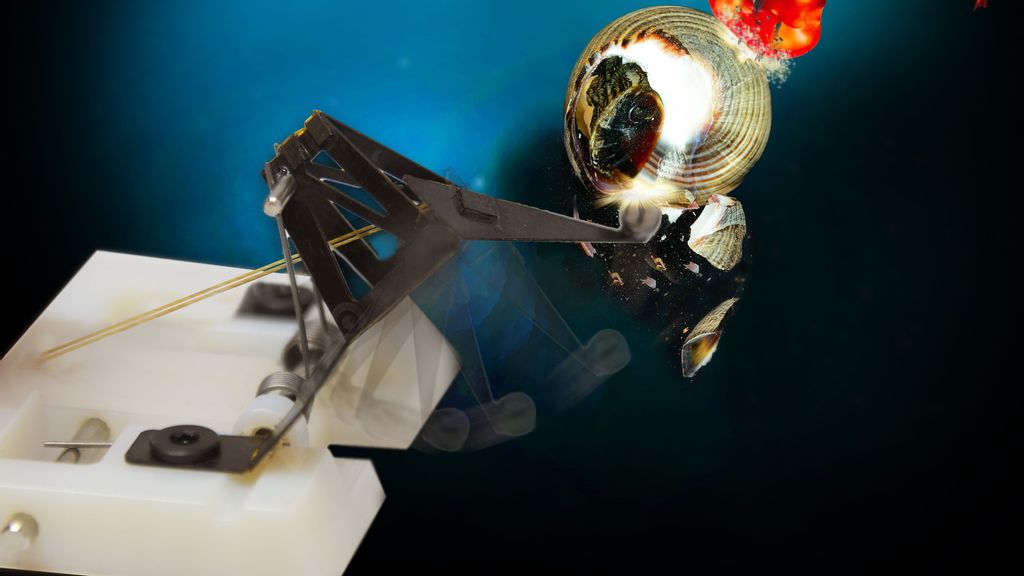Scientists have robotically mimicked the lightning-fast moves of the mantis shrimp, having learned how it unleashes a punch so fast that it creates a sonic boom, paving the way for powerful miniature robots.
High-speed imaging has allowed biologists to study how the crustaceans produce the fastest punch in the animal kingdom. The mantis shrimp’s club-like appendages accelerate faster than a speeding bullet. The sharp claws on the ends of their appendages can penetrate a snail shell, disarm a crab and kill fish with a single blow.
“We are fascinated by so many remarkable behaviors we see in nature, in particular when these behaviors meet or exceed what can be achieved by human-made devices,” said Harvard professor Robert Wood.
“The speed and force of mantis shrimp strikes, for example, are a consequence of a complex underlying mechanism. By constructing a robotic model of a mantis shrimp striking appendage, we are able to study these mechanisms in unprecedented detail,” said Wood, who teaches engineering and applied sciences.
With recent advancements in robotics and imaging, scientists can now not only observe and measure the mantis shrimp strikes, but also start to understand the mechanics of their stealthy moves.
Wood and an interdisciplinary team of roboticists, engineers and biologists published the results of their research in the Proceedings of the National Academy of Sciences. They developed a model that reveals the mechanics of the mantis shrimp’s punch, and then built a robot to mimic its movement.


This allowed them to better understand not only the biology of mantis shrimp, but to develop a small but powerful robot. It may also lead to better understanding how, for example, frogs can leap as quickly as they do.
Frogs, chameleons and some plants are among the organisms capable of ultra-fast movements. Like a mousetrap, they store elastic energy and rapidly release it through a latching mechanism.
Mantis shrimp have two small structures called sclerites embedded in their tendons that serve as a latch for their appendages. Once the physical latch is removed, the stored energy is immediately released, just like a spring-loaded mechanism.
In the mantis shrimp appendage, however, there is a notable difference in its release mechanism. “When you look at the striking process on an ultra-high-speed camera, there is a time delay between when the sclerites release and the appendage fires,” said co-author Nak-seung Hyun.
“It is as if a mouse triggered a mousetrap but instead of it snapping right away, there was a noticeable delay before it snapped. There is obviously another mechanism holding the appendage in place, but no one has been able to analytically understand how the other mechanism works,” he said.
Because mantis shrimp do not have special muscles when compared to other crustaceans, the researchers concluded that there was a mechanical mechanism producing the acceleration.
Earlier hypotheses suggested the sclerites initiate unlatching while the appendage’s geometry acts as a secondary latch, controlling the movement while continuing to store energy. The theory remained untested until now.

To test the hypothesis, the team studied the mechanics of the system and built a robotic model. Having the robot allowed them to create a mathematical model of the movement. Mapping the movement of the mantis strike, the researchers found that after the sclerites unlatch, the geometry of the mechanism takes over and holds the mantis appendage in place until it reaches an over-centering point and then the latch releases.
They found that the shrimp controls the release of stored elastic energy. “The geometric latching process reveals how organisms generate extremely high acceleration in these short duration movements, like punches,” said Emma Steinhardt, a graduate student at Harvard’s School of Engineering and Applied Sciences and first author of the paper.
The scientists’ shrimpy 1.5-gram robot could not match the speed of a mighty mantis shrimp, but at 26 meters per second in air — or the equivalent of a car reaching 58 mph in four milliseconds — it is faster than similar devices at the same scale. The mantis shrimp, however, overcomes the drag of much denser seawater.
The research may well may have some wider implications, those involved say.
“This study exemplifies how interdisciplinary collaborations can yield discoveries for multiple fields,” said co-author Sheila Patek, a biology professor at Duke University. “The process of building a physical model and developing the mathematical model led us to revisit our understanding of mantis shrimp strike mechanics and, more broadly, to discover how organisms and synthetic systems can use geometry to control extreme energy flow during ultra-fast, repeated-use, movements.”
Edited by Matthew B. Hall and Kristen Butler
The post VIDEO: Tiny Robot Packs As Fast A Punch As The Powerful Mantis Shrimp appeared first on Zenger News.

